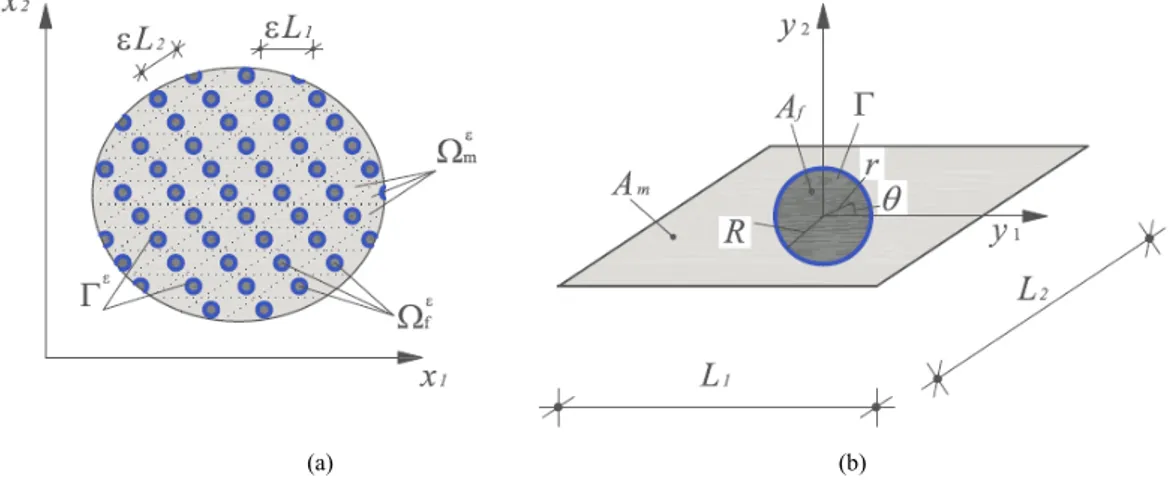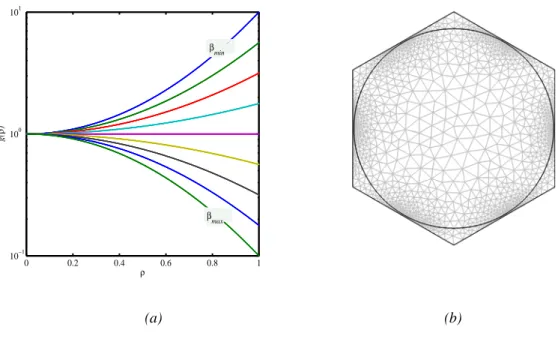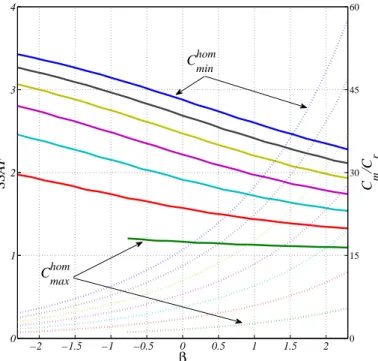Effective torsional stiffness of composite shafts reinforced by
functionally-graded fibres
Edoardo Artioli, Paolo Bisegna, Franco Maceri
Dipartimento di Ingegneria Civile, Università degli Studi di Roma “Tor Vergata” {artioli, bisegna, maceri}@ing.uniroma2.it
Parole chiave: functionally-graded materials, composite materials, homogenization, torsion.
SOMMARIO In questo lavoro si considera un albero a torsione in composito fibrato a matrice isotropa e fibre cilindriche parallele all’asse, in materiale a gradazione funzionale cilindricamente ortotropo. Si determina la rigidezza torsionale omogeneizzata dell’albero e l’assetto delle tensioni tangenziali all’interfaccia fibra-matrice, in funzione dei parametri di gradazione funzionale del materiale costituente le fibre.
ABSTRACT In this paper, a fibre-reinforced composite shaft is considered, comprising functionally graded, cylindrically-orthotropic, parallel fibres embedded into a homogeneous isotropic matrix. The aim of the analysis is to determine the effective torsional stiffness of the shaft and the shear stresses at the fibre-matrix interface. In particular, the main issue is to understand how these quantities depend on the grading features of the fibres.
1. STATEMENT OF THE PROBLEM
Reference is made to a torsion shaft whose cross section is portrayed in Figure 1 (a)-(b). The torsion problem is stated in terms of the Prandtl stress function ψ, and the homogenization limit is computed by letting the small parameter ε defining the period of the microstructure go to zero, by applying the asymptotic expansion method [1]. The homogenized problem turns out to be:
hom
div *⎡⎣ C ⎤ ∇⎦ ψ = −2Θ (1)
where Θ is the unit torsion angle and the symbol *( • ) is the Hodge star operator [2]. The homogenized shear elastic compliance tensor is defined as:
hom Y 1 * * ( Y t y C =
∫
C I− ∇χ) d (2)where Y is the unit cell, I the identity, and the Y-periodic null-average cell function χ satisfies:
(
)
(
)
div * 0 on * 0 on t f t m A A Γ C χ I C χ I n c f d g e h ⎡ ⎤ − ⎣ ∇ − ⎦= ∪ ∇ − ⋅ = (3)The shear compliance tensor C is CmI in the homogeneous and isotropic matrix, whereas it
depends on the material parameters Cr and Cθ and on the grading function g(ρ) in the fibre,
according to:
( )
r r r
C Cθ θ θ g ρ
C=⎡⎣ e ⊗e + e ⊗e ⎤⎦ (4)
where ρ = r/R is the dimensionless radial variable. Hence, the calculation of the homogenized shear compliance (2) relies on the solution of the cell problem, i.e. on solving equation (3) for χ.
2. CELL PROBLEM
(a) (b) Figure 1. (a) Composite cell arrangement. (b) Unit cell.
domain, as follows:
(
)
(
)
( )
(
)
(
)
i 1 i , , e ; , , e ; f m f o k h A h kh k h k m o k k h A h kh h k a F y h b y h θ θ χ ρ θ χ ρ θ ρ χ ρ θ χ ρ θ ρ +∞ = +∞ = −∞ ⎧ ⎫ = = ℜ⎨ ⎬+ = ⎩ ⎭ ⎧ ⎫ = = ℜ⎨ ⎬+ = ⎩ ⎭∑
∑
1, 2 1, 2 (5)where the unknown coefficients akh and bkh are chosen to satisfy, at the fibre-matrix interface ρ =
1, both the congruence interface conditions (3)2 and the equilibrium continuity requirement. The
functions Fk(ρ), taking into account the grading features of the fibres, are determined in the next
section. The Y-periodicity condition is enforced by resorting to the theory of Weierstrass elliptic functions, leading to the following representation for χm:
(
)
2 1 1(
( 1)( )
)
1 1 , ; 1 ! s m h lh l lh l l s z r w z w s ς χ θ η ω − ∞ = = ⎧ ⎡ ⎤⎫ ⎪ = ℜ⎨ ⎢− + − = ⎢ ⎥ ⎪ ⎣ ⎦⎪ ⎩∑
∑
⎭ 1, 2 h ⎪ ⎥⎬ (6)Here z=y1+iy2 is the complex variable, ζ(z) is the Weierstrass function, ωl and ηl are constants
related to the microstructure, and the coefficients wklh are to be determined. The solution of the cell
problem is achieved by identifying the two representations (5)2 and (6).
lex variable, ζ(z) is the Weierstrass function, ωl and ηl are constants
related to the microstructure, and the coefficients wklh are to be determined. The solution of the cell
problem is achieved by identifying the two representations (5)2 and (6).
3. EXPONENTIAL GRADING SOLUTION 3. EXPONENTIAL GRADING SOLUTION
In order to satisfy the field equation (3)1, the functions Fk(ρ) introduced in (5)1 must solve the
ordinary differential equation:
In order to satisfy the field equation (3)1, the functions Fk(ρ) introduced in (5)1 must solve the
ordinary differential equation:
1 2 2 0 k k g F F k g ρ σ ′ ⎛ ⎞ ′′ ′ k F +⎜ + ⎟ − = ⎝ ⎠ (7) where σ 2 = G
θ/Gr and a prime denotes derivation with respect to ρ. Assuming that the grading
function is
( )
exp(
q)
g ρ = −βρ (8)
and making the following change of variables:
(9) ; q k G σ ξ βρ= = ρ−k k F
101
(a) (b)
Figure 2. (a) grading function g(ρ). (b) Hexagonal unit cell. equation (7) is transformed into:
(
)
0k k k
G b G aG
ξ ′′+ −ξ ′− = (10)
where a prime denotes derivation with respect to the new independent variable ξ and:
; 1 2
a=kσ q b= + kσ q (11)
Remarkably, equation (10) is a canonical Kummer’s equation [2] and has a known closed form bounded solution. Recalling positions (9), the solution to the original problem (7) is finally deduced:
( )
(
(
; ;)
)
; ; q k k M a b F M a b σ βρ ρ ρ β = (12)where M(a;b;ρ) is the Kummer’s function of the first kind [2]. The homogenized shear modulus and, consequently, the torsion stiffness of the shaft may be calculated from equation (2). For further details on the solution procedure briefly sketched here, see References [3,4].
4. NUMERICAL RESULTS
In the present section the homogenized shear compliance of the composite material is computed by applying the method presented above. The aim is to determine the effect of the material grading parameter β on the homogenized shear compliance and on the value of the maximum shear stresses at the fibre-matrix interface. For the sake of compactness, a fibre material grading with
1 1
log10 , log10 ; q 2
β∈⎡ − ⎤ =
⎣ ⎦ (13)
is considered. The composite is assumed to have a cell which is a regular hexagon and a volume fraction of 90%. This implies that the homogenized compliance tensor becomes diagonal. In Figure 2 (a) the grading function g(ρ) according to (13) is reported, for some values of the parameter β, while Figure 2 (b) shows the unit cell geometry.
0 0.2 0.4 0.6 0.8 1 10−1 βmin 100 ρ g( ρ ) βmax
−2 −1.5 −1 −0.5 0 0.5 1 1.5 2 0 1 2 3 4 β SSAF 0 15 30 45 60 C m /C r Chom min Chom max
Figure 3. Shear stress amplification factor (SSAF) and dimensionless compliance at the fibre centre versus grading parameter β.
Figure 3 is aimed at developing a composite material with a specified homogenized value for Chom,
under the prescription of bounding the fibre-interface shear stress. Continuous lines indicate the shear stress amplification factor (SSAF), defined as the maximum shear stress at fibre/matrix interface divided by the shear stress into the homogenized material, as a function of the grading parameter β. Dotted lines represent the dependence of the ration Cm/Cr on the grading parameter β.
Different curves correspond to different values of the homogenized shear compliance modulus
Chom. The SSAF decreases as β increases and this pattern becomes more evident at higher values
of Chom. It is apparent that properly grading elastic properties of the fibres leads to a significant
decrease of the interfacial stresses, without reducing of the overall stiffness of the material.
Riferimenti bibliografici
[1] Bensoussan A, Lions JL, Papanicolaou G, Asymptotic Analysis of Periodic Structures, North Holland, 1978.
[2] Abramowitz M, Stegun IA, Handbook of Mathematical Functions with Formulas, Graphs
and Tables, New York, Dover, 1965.
[3] Bisegna P, Caselli F, A simple formula for the effective complex conductivity of periodic fibrous composites with interfacial impedance and applications to biological tissues, J. Phys.
D: Appl. Phys., 41, 2008, 115506 (13pp)
.
[4] Artioli E, Bisegna P, Maceri F, Effective longitudinal shear moduli of fibre-reinforced composites with graded fibres and imperfect interfaces, submitted, 2008.


